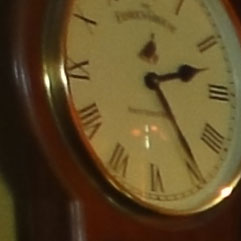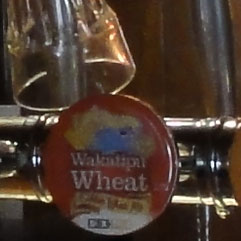Sony Cyber-shot DSC-HX5
-
-
Written by Gordon Laing
Sony Cyber-shot DSC-HX5: Handheld Twilight mode versus Program mode (at 400 ISO)
Sony Cyber-shot DSC-HX5 results : Real-life resolution / Sharpness wide-angle / Sharpness telephoto / High ISO Noise / HHT / AMB
Sony Cyber-shot DSC-HX5 results : Real-life resolution / Sharpness wide-angle / Sharpness telephoto / High ISO Noise / HHT / AMB
|
|
The Sony Cyber-shot DSC-HX5 offers two modes specifically designed for use in low light conditions. The Handheld Twilight and Anti Motion Blur modes both fire-off six frames in quick succession and stack them to deliver a single image with claims of better protection against noise and camera shake. On this page we’ve put the HX5’s Handheld Twilight mode to the test by photographing a variety of low light compositions. Handheld Twilight mode automatically selects the sensitivity and here opted for 400 ISO. |
Below are 100% crops from the Handheld Twilight sample, which under the conditions of the day automatically selected a sensitivity of 400 ISO. Interestingly the result was darker than a sample shot moments later in Program mode at 0EV, so we took a second comparative image in Program with -0.3EV compensation, at the same sensitivity of 400 ISO. You can see crops from this sample below the Handheld Twlight crops.
While there’s still a small difference in brightness (despite identical reported exposures), it’s clear the Handheld Twilight version is cleaner than the one shot in Program. The patchy noise artefacts of the Program version have been greatly reduced, with crisper edges. It’s as if the noise reduction has been increased, but without any negative side-effects. The actual degree of real-life detail is essentially the same, but by delivering a cleaner result without compromise, the Handheld Twilight version is definitely preferred.
A good result here for the Sony HX5, but there’s more examples to see, so scroll down for our second test image.
Sony Cyber-shot DSC-HX5: Handheld Twilight mode at 400 ISO | ||||
 |
 |  | ||
f4, 1/15, 400 ISO |
f4, 1/15, 400 ISO |
f4, 1/15, 400 ISO | ||
Sony Cyber-shot DSC-HX5: Program mode at 400 ISO | ||||
 |
 |  | ||
f4, 1/15, 400 ISO |
f4, 1/15, 400 ISO |
f4, 1/15, 400 ISO | ||
Sony Cyber-shot DSC-HX5: Handheld Twilight mode versus Program mode (at 400 ISO)
 | |
|---|---|
In this second example we’ve moved to the bar-setting seen in our Sample Images pages to see how Handheld Twilight mode copes with a common low-light situation. Once again Handheld Twilight mode automatically selects its operating sensitivity, and once again it’s gone for 400 ISO here. This time the camera metered exactly the same exposure in Program mode at 400 ISO without the need for any compensation. Both shots were handheld from the same position.
The crops below tell a similar story to those above: the Handheld Twilight image is noticeably cleaner than that taken in Program mode at the same sensitivity. The undesirable patchy artefacts of the Program image have been greatly reduced, but without compromising recorded detail. Again it’s like the noise reduction has been increased, but without any negative side-effects. Admittedly the Handheld Twilight version looks a little softer, but the actual recorded detail is similar.
So another good result for the HX5, and a two-love lead to Handheld Twilight mode over Program at 400 ISO.
Sony Cyber-shot DSC-HX5: Handheld Twilight mode at 400 ISO | ||||
 |
 |  | ||
f3.5, 1/15, 400 ISO |
f3.5, 1/15, 400 ISO |
f3.5, 1/15, 400 ISO | ||
Sony Cyber-shot DSC-HX5: Program mode at 400 ISO | ||||
 |
 |  | ||
f3.5, 1/15, 400 ISO |
f3.5, 1/15, 400 ISO |
f3.5, 1/15, 400 ISO | ||
Sony Cyber-shot DSC-HX5: Handheld Twilight mode versus Program mode (at 3200 ISO)
 | |
|---|---|
In our tests with Handheld Twilight mode, the camera almost always selected a sensitivity of 400 ISO. Curious to see how the mode impacted higher sensitivities, we sought-out a very dim environment for our third example here: a close-up shot of some metalwork on a table. The full view opposite looks quite well-lit, but in reality it was very dim, forcing Handheld Twilight mode to select a shutter speed of 1/8 at its top sensitivity of 3200 ISO. Once again we matched the exposure in Program mode for comparison. In each case here the camera was balanced on a lower shelf and the shutter fired by self-timer.
Unfortunately there’s not a great deal of very fine detail in this shot, but from the crops below, it’s clear the Handheld Twilight version is again much preferred. Both samples are of course noisy, but the one shot in Handheld Twilight mode is simply much cleaner, and this time also includes finer details despite a softer-looking appearance. So three-love to Handheld Twilight and a clear victory over Program and Manual modes at the same sensitivities.
This is a great result for the Sony Cyber-shot HX5, and a key advantage it has over the competition. Handheld Twilight mode may not deliver DSLR-like performance at high sensitivities, but it will give you a noticeably superior result to the normal shooting modes at the same ISO settings. Indeed if the camera reports 400 ISO or higher in any mode, whether Program or Auto, we’d recommend switching to Handheld Twilight instead as it will almost certainly deliver a better-looking result.
But this isn’t the only unique shooting mode on the Cyber-shot HX5, so check out our new Anti Motion Blur results for a detailed look at this alternative mode.
Sony Cyber-shot DSC-HX5: Handheld Twilight mode at 3200 ISO | ||||
 |
 |  | ||
f3.5, 1/8, 3200 ISO |
f3.5, 1/8, 3200 ISO |
f3.5, 1/8, 3200 ISO | ||
Sony Cyber-shot DSC-HX5: Program mode at 3200 ISO | ||||
 |
 |  | ||
f3.5, 1/8, 3200 ISO |
f3.5, 1/8, 3200 ISO |
f3.5, 1/8, 3200 ISO | ||





